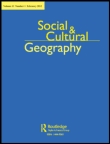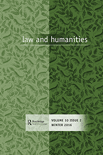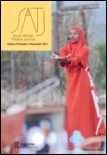
Geohumanities
Scope & Guideline
Exploring the Intersections of Space and Culture
Introduction
Aims and Scopes
- Interdisciplinary Approaches:
Geohumanities blends methodologies from geography, literature, art, and cultural studies to explore complex spatial narratives and human experiences. - Focus on Place and Identity:
The journal emphasizes how place influences identity and community, often through the lens of historical and contemporary socio-political issues. - Creative and Artistic Expression:
Many articles utilize artistic practices, such as creative writing, visual arts, and performance, to engage with geographical themes and human narratives. - Environmental and Ecological Concerns:
The journal addresses pressing environmental issues, examining the interplay between human activities, ecological systems, and the Anthropocene. - Decolonial and Anti-Colonial Perspectives:
There is a strong focus on decolonial methodologies and anti-colonial narratives, exploring how geographical knowledge can challenge dominant power structures.
Trending and Emerging
- Decolonial Geographies:
An increasing number of publications focus on decolonial perspectives, examining how geographical knowledge and practices can challenge colonial narratives and promote indigenous voices. - More-than-Human Relationships:
There is a growing interest in exploring relationships that transcend human experiences, including the agency of non-human entities and the interconnectedness of ecosystems. - Art as Methodology:
Creative methodologies, such as artistic interventions and participatory practices, are gaining traction, allowing researchers to engage with geographical issues in innovative and impactful ways. - Environmental Justice and Activism:
Emerging themes are increasingly centered on environmental justice, highlighting activism, community engagement, and the socio-political dimensions of ecological issues. - Affective and Emotional Geographies:
There is a rising focus on the affective dimensions of geography, exploring how emotions shape our understanding of space and place, and how they influence social relations.
Declining or Waning
- Traditional Geographic Methods:
There is a noticeable decline in the use of traditional geographic methodologies, such as quantitative analysis and cartography, as the journal increasingly favors qualitative and artistic approaches. - Static Representations of Space:
Themes that focus solely on static or historical representations of space are becoming less frequent, as the journal prioritizes dynamic and participatory engagements with geography. - Exclusive Focus on Western Contexts:
Papers that exclusively address Western geographical contexts are diminishing, giving way to a broader global perspective that includes diverse voices and experiences. - Narrowly Defined Environmental Issues:
Research focused on narrowly defined environmental issues without a cultural or artistic lens is declining in favor of more interdisciplinary approaches that integrate human narratives with ecological concerns.
Similar Journals

Camino Real-Estudios de las Hispanidades Norteamericanas
Charting New Paths in the Study of North American HispanidadesCamino Real-Estudios de las Hispanidades Norteamericanas is an esteemed journal published by the Universidad de Alcalá, Instituto Franklin de Investigación Norteamericanos, focusing on the interdisciplinary study of North American Hispanic studies. With a dedicated mission to advance scholarship in this emerging field, the journal serves as a crucial platform for researchers, academics, and students interested in exploring the cultural, historical, and social dynamics of Hispanic populations in North America. While the journal does not currently operate under an Open Access model, it is committed to rigorous peer review and upholding academic standards that are essential for quality research dissemination. Situated in Alcalá de Henares, Spain, this journal not only contributes to the understanding of Hispanic influences in North American contexts but also strengthens the dialogue between diverse scholarly communities, making it a valuable resource for anyone engaged in this vital area of study.

SOCIAL & CULTURAL GEOGRAPHY
Shaping contemporary thought in social and cultural contexts.SOCIAL & CULTURAL GEOGRAPHY, published by Routledge Journals, Taylor & Francis Ltd, stands as a leading platform for innovative research in the fields of cultural studies and geography. With an impressive impact factor reflected in its Q1 ranking in both Cultural Studies and Geography, Planning and Development categories, this journal houses high-quality articles and theoretical frameworks that shape contemporary discussions in social and cultural geography. Its rigorous indexing, including a commendable Scopus Rank—#20 out of 1304 in Cultural Studies—underscores its significance and influence in the academic community. Operating since 2000 and continuing to thrive until 2024, SOCIAL & CULTURAL GEOGRAPHY promotes interdisciplinary dialogues while fostering a deeper understanding of the intricate relationships between society and space. We encourage researchers, professionals, and students to engage with resourceful insights and critical perspectives published in this pivotal journal, thereby contributing to the evolving landscape of geographical thought.

Technoetic Arts
Bridging Philosophy and Creativity in a Digital AgeTechnoetic Arts, an influential journal published by INTELLECT LTD, serves as a vital platform for interdisciplinary research at the intersection of the arts, philosophy, and technology. Established in 2003, this journal has evolved to encompass a diverse range of innovative topics, while focusing on the critical examination of art's future amid rapid technological advances. With an ISSN of 1477-965X and E-ISSN 1758-9533, it appeals to researchers, professionals, and students interested in explorations within the fields of Computer Science Applications, Human-Computer Interaction, Philosophy, and Visual Arts and Performing Arts. Although currently not open access, Technoetic Arts is recognized for its rigorous scholarship, as evidenced by its Scopus rankings—achieving the 75th percentile in Visual Arts and Performing Arts. The journal operates from its base in the United Kingdom, offering a unique lens through which contemporary techno-artistic dialogues are examined and promoted. As it aims for continuous improvement in academic merit and relevance, Technoetic Arts remains an essential resource for anyone looking to engage with the transformative power of technology in art.

Tercio Creciente
Exploring Innovative Perspectives in Humanities and Social SciencesTercio Creciente is a distinguished academic journal published by UNIV JAEN, SERV PUBLICACIONES, focusing on innovative research and discourse in the fields of humanities and social sciences. Since its inception as an Open Access publication in 2012, Tercio Creciente has aimed to democratize knowledge and foster greater accessibility to scholarly works, thereby enhancing the academic community’s engagement with contemporary issues. With a commitment to rigorous peer review and high-quality contributions, the journal serves as a critical platform for researchers, professionals, and students keen on exploring multidisciplinary perspectives. Located at CAMPUS LAGUNILLAS S-N, EDIFICIO BIBLIOTECA, 2A PLANTA, JAEN 23071, SPAIN, Tercio Creciente aspires to advance scholarly communication and contribute meaningfully to the evolving landscape of its respective fields.

Law and Humanities
Illuminating the Intersections of Law and PhilosophyLaw and Humanities, published by Routledge Journals, Taylor & Francis Ltd, serves as a pivotal platform at the intersection of legal studies and humanities, exploring the intricate relationships between law, culture, philosophy, and history. With an ISSN of 1752-1483 and an E-ISSN of 1752-1491, this esteemed journal has established its reputation within the academic community, achieving a Q2 ranking in the Arts and Humanities (miscellaneous) and a Q3 ranking in Law by 2023 metrics. It provides valuable insights and fosters critical dialogue among researchers, practitioners, and students, creating a comprehensive understanding of legal frameworks through a humanities lens. Although not currently open access, the journal's rigorous selection process ensures that published papers contribute significantly to the field, making it an essential resource for anyone interested in the dynamic interplay of law and human experience. Located in the United Kingdom, it continues to shape scholarly discourse from 2007 through its converged years, from 2014 to 2024, as it addresses the evolving challenges and inquiries that define contemporary legal thought.

Open Library of Humanities
Exploring Contemporary Issues Through Scholarly InsightThe Open Library of Humanities, a premier platform established in 2015 and based in the United Kingdom, elevates the discourse in the fields of Anthropology, Arts and Humanities, Cultural Studies, and Sociology and Political Science. Published by OPEN LIBRARY OF HUMANITIES, this open access journal provides a prominently accessible space for scholars and researchers to disseminate their findings and contribute to a diverse range of academic conversations. With an impressive Scopus ranking that reflects its influence—ranking in the 87th percentile in General Arts and Humanities and in the 80th percentile for Cultural Studies—the journal is recognized for publishing high-quality research that addresses significant and contemporary issues within its scope. By embracing a multidisciplinary approach, the Open Library of Humanities fosters interdisciplinary dialogue and encourages innovative research dissemination practices. Scholars, students, and practitioners are invited to engage with the latest developments and theoretical insights that enrich our understanding of the human experience.

Revista de Humanidades
Connecting Scholars Through Open Access ResearchRevista de Humanidades, published by UNIV NACIONAL EDUCACION DISTANCIA in Spain, is a distinguished open-access journal that has proudly embraced the principles of accessibility and scholarly dissemination since 2010. With an ISSN of 1130-5029 and an E-ISSN of 2340-8995, this journal caters to a broad spectrum of topics within the arts and humanities, fostering academic dialogue and knowledge sharing. It achieved a Q3 ranking in the Arts and Humanities (Miscellaneous) category for 2023, placing it in the 52nd percentile among its peers, highlighting its commitment to quality research and scholarly excellence. Researchers, professionals, and students can access its rich repository of articles and studies that span various disciplines within the humanities. With a clear focus on promoting interdisciplinary approaches and critical thought, Revista de Humanidades serves as an essential platform for emerging and established scholars alike, contributing to the ongoing evolution of the humanities field.

BRAC-Barcelona Research Art Creation
Unlocking New Perspectives in Artistic ResearchBRAC-Barcelona Research Art Creation, published by HIPATIA PRESS, is a prominent open access journal dedicated to advancing scholarship in the fields of Visual Arts and Performing Arts. Since its inception in 2013, this journal has become a vital resource for researchers, practitioners, and students, offering a platform for innovative research and critical discourse in art creation. With an impressive impact factor represented by its Q2 ranking in the 2023 category of Visual Arts and Performing Arts, BRAC serves a pivotal role within the academic community, providing essential insights and contributions to the understanding and practice of art in contemporary society. The journal's commitment to open access ensures that significant research findings are readily available to a global audience, fostering interdisciplinary collaborations and the exchange of ideas across borders. As it converges from 2019 to 2024, BRAC continues to elevate artistic research and dialogue, making it an indispensable asset for those invested in the vibrant world of the arts.

PsyArt Journal-Online Journal for the Psychological Study of the Arts
Bridging Disciplines: Discovering the Psychology Behind Artistic CreationPsyArt Journal is a leading online journal dedicated to the psychological study of the arts, published by the PSYART FOUNDATION. With an E-ISSN of 1088-5870, this journal provides a dynamic platform for researchers, professionals, and students to explore the intricate connections between psychology and various art forms. While specific metrics such as impact factor and h-index are not disclosed, its commitment to advancing the understanding of artistic expression through psychological lenses is unparalleled. PsyArt Journal embraces an open-access approach, allowing for wide dissemination of research and fostering a collaborative academic environment. The journal covers a broad scope including, but not limited to, visual arts, music, literature, and performance, providing valuable insights into how art influences mental processes and vice versa. Situated in the vibrant academic landscape of Cambridge, MA, PsyArt Journal continues to attract a diverse range of scholarly articles, reviews, and theoretical discussions, making it an essential resource for anyone invested in the intersection of psychology and the arts.

South African Theatre Journal
Illuminating the Impact of Socio-Political Contexts on ArtSouth African Theatre Journal, published by Routledge Journals, Taylor & Francis Ltd, is an essential platform for researchers and practitioners in the fields of Visual Arts and Performing Arts. With an ISSN of 1013-7548 and an E-ISSN of 2163-7660, this journal has been contributing to the discourse on diverse theatrical practices and performance studies since its inception in 1996. The journal's focus encompasses a variety of topics, including but not limited to, South African theatre, intercultural performance, and the impact of socio-political contexts on artistic expression. Although it does not currently offer open access, its significance is reflected in its Q3 category in Visual Arts and Performing Arts and a ranking of #449/667 in the Scopus Arts and Humanities sector, positioning it as a noteworthy resource for scholars striving to explore and analyze the rich tapestry of theatrical work in South Africa. The South African Theatre Journal serves as a vital conduit for critical engagement and scholarly dialogue, making it indispensable for students, researchers, and professionals dedicated to the advancement of performing arts research.